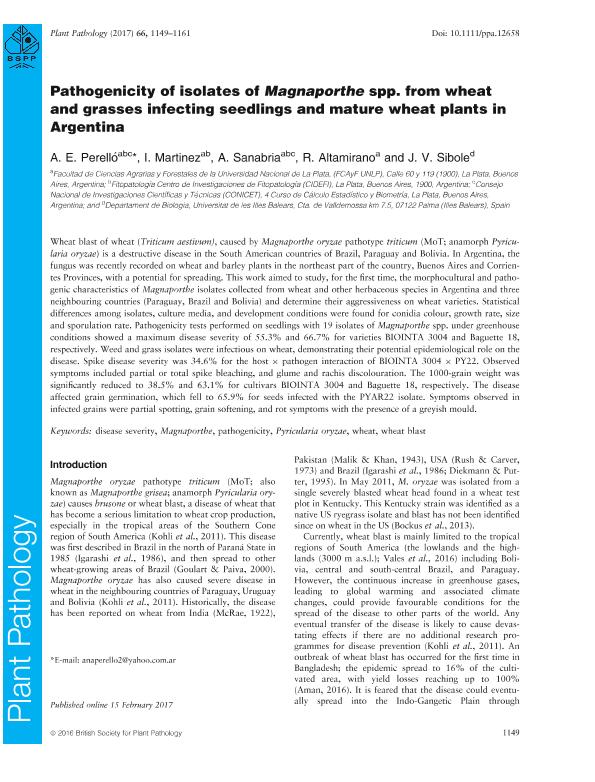Mostrar el registro sencillo del ítem
dc.contributor.author
Perello, Analia Edith

dc.contributor.author
Martinez, Sergio Ivan

dc.contributor.author
Sanabria Páez, Analía Teresa

dc.contributor.author
Altamirano, Rodrigo
dc.contributor.author
Sibole, Jhon
dc.date.available
2021-04-14T11:53:01Z
dc.date.issued
2017-09
dc.identifier.citation
Perello, Analia Edith; Martinez, Sergio Ivan; Sanabria Páez, Analía Teresa; Altamirano, Rodrigo; Sibole, Jhon; Pathogenicity of isolates of Magnaporthe spp. from wheat and grasses infecting seedlings and mature wheat plants in Argentina; Wiley Blackwell Publishing, Inc; Plant Pathology; 66; 7; 9-2017; 1149-1161
dc.identifier.issn
0032-0862
dc.identifier.uri
http://hdl.handle.net/11336/129999
dc.description.abstract
Wheat blast of wheat (Triticum aestivum), caused by Magnaporthe oryzae pathotype triticum (MoT; anamorph Pyricularia oryzae) is a destructive disease in the South American countries of Brazil, Paraguay and Bolivia. In Argentina, the fungus was recently recorded on wheat and barley plants in the northeast part of the country, Buenos Aires and Corrientes Provinces, with a potential for spreading. This work aimed to study, for the first time, the morphocultural and pathogenic characteristics of Magnaporthe isolates collected from wheat and other herbaceous species in Argentina and three neighbouring countries (Paraguay, Brazil and Bolivia) and determine their aggressiveness on wheat varieties. Statistical differences among isolates, culture media, and development conditions were found for conidia colour, growth rate, size and sporulation rate. Pathogenicity tests performed on seedlings with 19 isolates of Magnaporthe spp. under greenhouse conditions showed a maximum disease severity of 55.3% and 66.7% for varieties BIOINTA 3004 and Baguette 18, respectively. Weed and grass isolates were infectious on wheat, demonstrating their potential epidemiological role on the disease. Spike disease severity was 34.6% for the host × pathogen interaction of BIOINTA 3004 × PY22. Observed symptoms included partial or total spike bleaching, and glume and rachis discolouration. The 1000-grain weight was significantly reduced to 38.5% and 63.1% for cultivars BIOINTA 3004 and Baguette 18, respectively. The disease affected grain germination, which fell to 65.9% for seeds infected with the PYAR22 isolate. Symptoms observed in infected grains were partial spotting, grain softening, and rot symptoms with the presence of a greyish mould.
dc.format
application/pdf
dc.language.iso
eng
dc.publisher
Wiley Blackwell Publishing, Inc

dc.rights
info:eu-repo/semantics/openAccess
dc.rights.uri
https://creativecommons.org/licenses/by-nc-sa/2.5/ar/
dc.subject
DISEASE SEVERITY
dc.subject
MAGNAPORTHE
dc.subject
PATHOGENICITY
dc.subject
PYRICULARIA ORYZAE
dc.subject
WHEAT
dc.subject
WHEAT BLAST
dc.subject.classification
Otras Ciencias Agrícolas

dc.subject.classification
Otras Ciencias Agrícolas

dc.subject.classification
CIENCIAS AGRÍCOLAS

dc.title
Pathogenicity of isolates of Magnaporthe spp. from wheat and grasses infecting seedlings and mature wheat plants in Argentina
dc.type
info:eu-repo/semantics/article
dc.type
info:ar-repo/semantics/artículo
dc.type
info:eu-repo/semantics/publishedVersion
dc.date.updated
2021-04-12T16:19:40Z
dc.journal.volume
66
dc.journal.number
7
dc.journal.pagination
1149-1161
dc.journal.pais
Reino Unido

dc.journal.ciudad
Londres
dc.description.fil
Fil: Perello, Analia Edith. Universidad Nacional de La Plata. Facultad de Ciencias Agrarias y Forestales. Departamento de Ciencias Biológicas. Centro de Investigaciones de Fitopatología. Provincia de Buenos Aires. Gobernación. Comisión de Investigaciones Científicas. Centro de Investigaciones de Fitopatología; Argentina. Universidad Nacional de La Plata. Facultad de Ciencias Agrarias y Forestales; Argentina. Consejo Nacional de Investigaciones Científicas y Técnicas. Centro Científico Tecnológico Conicet - La Plata; Argentina
dc.description.fil
Fil: Martinez, Sergio Ivan. Universidad Nacional de La Plata. Facultad de Ciencias Agrarias y Forestales. Departamento de Ciencias Biológicas. Centro de Investigaciones de Fitopatología. Provincia de Buenos Aires. Gobernación. Comisión de Investigaciones Científicas. Centro de Investigaciones de Fitopatología; Argentina. Universidad Nacional de La Plata. Facultad de Ciencias Agrarias y Forestales; Argentina. Consejo Nacional de Investigaciones Científicas y Técnicas. Centro Científico Tecnológico Conicet - La Plata; Argentina
dc.description.fil
Fil: Sanabria Páez, Analía Teresa. Universidad Nacional de La Plata. Facultad de Ciencias Agrarias y Forestales. Departamento de Ciencias Biológicas. Centro de Investigaciones de Fitopatología. Provincia de Buenos Aires. Gobernación. Comisión de Investigaciones Científicas. Centro de Investigaciones de Fitopatología; Argentina. Consejo Nacional de Investigaciones Científicas y Técnicas. Centro Científico Tecnológico Conicet - La Plata; Argentina. Universidad Nacional de La Plata. Facultad de Ciencias Agrarias y Forestales; Argentina
dc.description.fil
Fil: Altamirano, Rodrigo. Universidad Nacional de La Plata. Facultad de Ciencias Agrarias y Forestales; Argentina
dc.description.fil
Fil: Sibole, Jhon. Universidad de las Islas Baleares; España
dc.journal.title
Plant Pathology

dc.relation.alternativeid
info:eu-repo/semantics/altIdentifier/doi/http://dx.doi.org/10.1111/ppa.12658
dc.relation.alternativeid
info:eu-repo/semantics/altIdentifier/url/https://bsppjournals.onlinelibrary.wiley.com/doi/full/10.1111/ppa.12658
Archivos asociados
